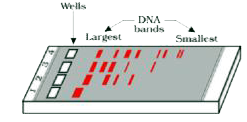Gel is:
liquid dispersed in gas
liquid dispersed m solid
solid dispersed in gas
gas dispersed in solid
The correct Answer is:B
Step-by-Step Solution:
1. Understanding Gels: Gels are a type of colloidal system. In colloids, one substance (the dispersed phase) is distributed evenly throughout another substance (the dispersion medium).
2. Identifying the Components: In the case of gels, the dispersed phase is typically a liquid, while the dispersion medium is a solid. This means that the liquid is spread throughout the solid matrix.
3. Examples of Gels: Common examples of gels include substances like curd and cheese, where liquid components are trapped within a solid structure.
4. Conclusion: Therefore, a gel can be defined as a system where a liquid is dispersed in a solid.
Final Answer: Gel is a system where liquid is dispersed in solid.
---
Topper's Solved these Questions
- SURFACE CHEMISTRY BOOK - ICSECHAPTER - SURFACE CHEMISTRY EXERCISE - EXERCISE (PART-I ( OBJECTIVE QUESTIONS )) (Match the following :)
1 Videos
- SURFACE CHEMISTRY BOOK - ICSECHAPTER - SURFACE CHEMISTRY EXERCISE - EXERCISE (PART-II ( DESCRIPTIVE QUESTIONS )) (VERY SHORT ANSWER QUESTIONS)
31 Videos
- SURFACE CHEMISTRY BOOK - ICSECHAPTER - SURFACE CHEMISTRY EXERCISE - EXERCISE (PART-I ( OBJECTIVE QUESTIONS ))
35 Videos
- SPECIMEN QUESTION PAPERBOOK - ICSECHAPTER - SPECIMEN QUESTION PAPEREXERCISE - QUESTION
140 Videos
- THE SOLID STATEBOOK - ICSECHAPTER - THE SOLID STATEEXERCISE - MULTIPLE CHOICE QUESTIONS (Assertion-Reason based questions)
10 Videos
Similar Questions
Comprehension # 1
Many lyophilic sols and few lyophobic sols when coagulated under some special conditions changes into semi rigid mass, enclosing whole amount of liquid within itself, it is called gel and the process is called gelation, Gelatin Agar-agar, gum-Arabic can be converted into gels by cooling them under moderate concentration conditions. Hydrophobic sols like silicic acid. Al(OH)3 are prepared by double decomposition and exchange of solvent method.
Types of Gel :
(i) Elastic gel : Those gel which have elastic properties.
Ex : Gelatin, Strach, Agar-agar etc.
(ii) Non-elastic gel : Those gel which are rigid.
Ex : Silica gel.
Properties of Gel :
1. Syneresis/weeping of gel : The spontaneous liberation of liquid from a gel is called syneresis or weeping of gels. It is reverse of swelling.
Ex : Gelatin, Agar-Agar show syneresis at low concentration while sillicic acid shows it at high concentration.
2. Imbibition or swelling of gel : When gel is kept in a suitable liquid (water) it absorb large volume of liquid. The phenomenon is called imbibition or swelling of gel.
3. Thixotropic : Some gels when shaken to form a sol, on keeping changes into gel are termed as thixotropic gel and phenomenon is called thixotropy.
Ex : Gelatin and silica liquify on shaking changing into corresponding sol and sol on keeping changes back into gel.
Which of the following is used to adsorb water ?
View SolutionGel electrophoresis is used for
View Solution
Knowledge Check
Gel electrophoresis is a
Atechnique of separation of charged molecules under the influence of magnetic fieldBtechnique of incorpotation of DNA molecules into the cell through transient pores made due to electrical impulsesCtechnique of separation of DNA fragments through the pores of agarose gel under the influence of electric fieldDtechnique of separation and purification of gene products.Gel electrophoresis is a
Atechnique of separation of charged molecules under the influence of magnetic fieldBtechnique of incorpotation of DNA molecules into the cell through transient pores made due to electrical impulsesCtechnique of separation of DNA fragments through the pores of agarose gel under the influence of electric fieldDtechnique of separation and purification of gene products.Gel electrophoresis is used for
AConstruction of recombinant DNA by joining with cloning vectorsBIsolation of DNA moleculesCCutting of DNA into fragmentsDSeparation of DNA fragments to their size
Gel electrophoresis is used for
View SolutionGel electrophoresis is used for
View SolutionGiven below is a typical agarose gel in which electrophoresis had occurred

In this agarose gel -
View SolutionHydrophilic gels, when placed in water, absorb liquid resulting in an increase of their volume. This process of swelling of gels takes place with:
View SolutionMany lyophilic sols and few lyophobic sols when coagulated under some special conditions changes into semi rigid mass, enclosing whole amount of liquid within of liquid within itself, it is called gel and the process is called gelation. Gelatin, agar-agar, gum-Arabic can be converted into gels by cooling them under moderate concentration conditions. Hydrophobic sols like silicic acid. Al(OH)3 are prepared by double decomposition and exchanged of solvent method.
Types of gel :
1. Syneresis/weeping of gel : The spontaneous liberation of liquid from a gel is called syneresis or weeping of gels. It is reverse of swelling.
e.g., geletin, agar-agar show syneresis at low concentration while silicic shows it at high concentration.
2. Imbibition or swelling of gel : When gel is kept in a suitable liquid (water) it absorb large volume of liquid. The phenomenon is called imbibition or sweeling of gel.
3. Thixotropic : Some gels when shaken to form a sol, on keeping changes into gel are termed as thixotropic gel and phenomenon is called thixotropy.
e.g., gelatin and silica liquify on shaking changing into corresponding sol and the sol on keeping changes back into gel.
Some types of gels like gelatin and silica liquify on shaking thereby changing into sols. The sols on standing change back into gels. This process is know as :
View Solution
